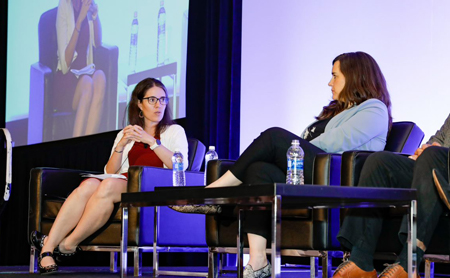Turning the River Around at the Public Health TechXpo
May 24, 2023 | Dylan Reynolds
 When Allison Arwady, commissioner of the Chicago Department of Public Health, stepped on stage at the ASTHO Public Health TechXpo and Futures Forum in Chicago on Tuesday, May 23, audience members expected her to open her speech by perhaps addressing one of the week’s themes: Building a modern workforce. Connecting the nation’s disparate data systems. The future of measuring health equity.
When Allison Arwady, commissioner of the Chicago Department of Public Health, stepped on stage at the ASTHO Public Health TechXpo and Futures Forum in Chicago on Tuesday, May 23, audience members expected her to open her speech by perhaps addressing one of the week’s themes: Building a modern workforce. Connecting the nation’s disparate data systems. The future of measuring health equity.
Instead, she had a different sort of story in mind.
“In the 1880s, [Chicago]’s growth—in fact, its existence—was being limited by infectious diseases,” said Arwady. “Cholera. Typhoid. We had one of the worst mortality rates for children under five in the country…It became clear that for this city to grow, we needed to solve this infectious disease problem.”
Arwady shared that as a better understanding of germ theory crept into the public consciousness throughout the 1800s, the reasons behind these debilitating outbreaks became abundantly clear. “From the beginning of Chicago’s founding, we had used the Chicago River as our sewer. Human waste, animal waste, construction waste—it all went into the river, and the river flowed into Lake Michigan,” said Arwady. “Well, where did we get our drinking water, both then and now? Lake Michigan.”
For around a decade, city officials tried a variety of tactics to quell the growing threat of disease. This included piping in water from surrounding areas, shipping in bottled water, and making minor adjustments to the city’s infrastructure. However, such methods proved either too expensive or too unimpactful.
After a decade of trial and error, experts at the Chicago Department of Public Health floated an idea that, on the face of it, was impossible. They were going to try to reverse the flow of the entire Chicago River.
Through an unprecedented partnership between the city’s public health and infrastructure experts, the city underwent a civil engineering transformation consisting of an elaborate network of canals and locks, designed to use gravity to change the direction of the river. In January of 1900, after years of extensive planning and construction, city officials raised a series of carefully orchestrated dams, and watched as the polluted Chicago River changed directions, away from Lake Michigan and the city’s water supply. This feat, now called the "Civil Engineering Monument of the Millennium,” became a living testament to what public health can accomplish in the face of adversity.
As in any sector, there is often talk in the public health field of “working upstream,” or addressing problems at their source. However, Arwady’s story—delivered just a short block away from the Chicago River—had a bolder mission in mind. If public health is going to be a changemaker in the world, its leaders must be equal parts nimble and innovative. They must be inclusive of all people and ideas, while laying scrutiny upon the status quo. They must be willing to ask questions that, at their face, might seem impossible to answer.
In short, they must be willing to turn the river around.
The Next Wave of Public Health Infrastructure
Following opening remarks from Arwady and her peers, attendees at the TechXpo heard from ASTHO President Anne Zink (SHO-AK), as she sat on stage alongside some of the nation’s top federal health officials, including Jennifer Layden, acting director of the Office of Public Health Data, Surveillance, and Technology at CDC; Sara Patterson, a senior advisor at CDC; and Micky Tripathi, national coordinator for health information technology at HHS. Zink opened the dialogue with a message about public health’s profound influence on life expectancy over the years, which for Zink can be understood as occurring in three distinct waves.
The first major jump in life expectancy came in the late 1800s, with a new and growing understanding of germ theory. The second wave came some decades later, with the advent of diagnostic medicine, including the expansion of vaccines and antibiotics.
The third wave of the life expectancy revolution, Zink says, is upon us. “Unfortunately, the United States as a whole has plummeting life expectancy rates, with the highest cost per capita, and medical healthcare is our number reason for bankruptcy. And that is because of the way our systems are put together.”
For Zink, this attention to a systems-level change will help define the direction that equitable improvements to life expectancy take in the years to come. And these are the types of conversations that the Public Health TechXpo and Futures Forum is here to serve. Over the course of the week, our attendees will hear from some of the nation’s biggest names in public health, technology, and healthcare policy. We will reflect on the COVID-19 pandemic and ask hard questions about what we failed to accomplish and who we failed to serve. We will look to the future, and ask how we can turn the river.
As with any convening, these conversations are designed to be held onto long after the end of the conference. TechXpo attendees will take these messages to their health agencies and partners, elevating them and spurring action.
After the in-person gathering, the TechXpo will continue with a virtual event on June 15, 2023, offering exclusive content for all participants seeking to continue this exploration of the future of public health. Registration is still open, and all are encouraged to join in the dialogue.